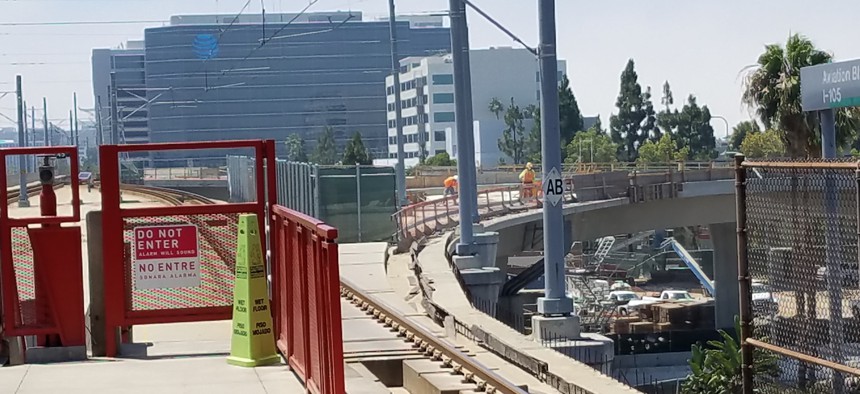What’s the ‘Most Impactful Thing’ Trump Will Do for Infrastructure?

Los Angeles Metro is currently constructing a new light-rail line that will serve LAX Airport. Michael Grass / Route Fifty

Connecting state and local government leaders
At the U.S. Conference of Mayors annual meeting, Los Angeles Mayor Eric Garcetti spoke with the White House’s point person on infrastructure about the need for federal grants to incentivize innovation and maintenance.
MIAMI BEACH, Fla. — Los Angeles Mayor Eric Garcetti on Friday stressed the need for federal infrastructure grants allowing cities to innovate, as well as longer-term incentives to perform maintenance.
President Trump’s administration proposed significant cuts to infrastructure funding, $800 million from New Starts and all $500 million of Transportation Investment Generating Economic Recovery (TIGER) grants, in its fiscal year 2018 spending plan.
Garcetti, mayor of the nation’s second-largest city, broached a bipartisan approach to financing infrastructure involving public-private partnerships (P3s), local money, federal grants and streamlined statutes with D.J. Gribbin, the first-ever special assistant to the president for infrastructure, at the U.S. Conference of Mayors 85th annual meeting in Miami Beach.
“We want to see innovation be a strong piece of what the federal government helps us do,” Garcetti said.
For instance, Tesla CEO Elon Musk wants to revolutionize tunneling under L.A. as he continues to work on Hyperloop, a proposed high-speed transportation system that moves passengers and freight via pods jettisoned through tubes.
The competitive TIGER grants program, created by the Obama administration in 2009, could prove vital to such projects, and the replacement Gribbin hinted at sounds awfully similar. A notice of funding availability would be issued in a transparent, objective process funding “transformative projects” that “leverage federal taxpayer dollars as high as possible,” Gribbin said. Because that structure favors dense, urban areas, rural America would need to be accommodated as well.
"You can’t go to the federal market and borrow money for untested concepts,” Gribbin said.
The Trump administration plans to spend $200 billion to incentivize alternate state and local revenue streams like Los Angeles County’s voter-approved Measure M, a half-percent sales tax increase projected to bring in $860 million annually, he said.
Mayors like Garcetti would like to see their cities rewarded for fronting infrastructure funding, but Measure M was cited in Trump’s budget proposal as justification for cuts to federal grants.
The federal government simply can’t provide all $4 trillion needed for infrastructure in the U.S., given competing demands like defense and health care, Gribbin said, but it can encourage tolling a road or establishing a tax benefit assessment district.
“We’ll likely be agnostic as to what that is,” he said.
Pipes, sewers and energy infrastructure also need maintenance, which isn’t easy to explain to taxpayers.
“They don’t understand why those things take more investment,” Garcetti said.
Gribbin estimates there is $108 billion in funds worldwide that could be available for U.S. infrastructure projects tomorrow, but “it’s an unbelievable, convoluted process that we’ve developed” to get them done. His team is looking to change and “scale back” statutes unnecessarily slowing work down, not just environmental reviews but places in the permitting process where agencies overlap.
That will be the “most impactful thing” the administration will do, Gribbin predicted, saying $3.6 trillion in additional economic activity is possible if the permitting process is shortened from 10 years to two.
Garcetti acknowledged Democratic mayors need to be flexible where the environment is concerned, just as Republican mayors need to be open to new taxes for infrastructure projects.
“You have a president who is a builder,” Gribbin said, someone “who believes passionately that the process we have currently is not working.”
Dave Nyczepir is a News Editor at Government Executive’s Route Fifty and is based in Washington, D.C.

NEXT STORY: Hybrid IT and data security musts





